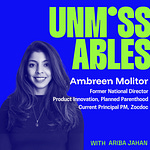“Presence isn’t about holding someone’s attention, it’s about making them feel like they belong inside the story.” - Aditi Rajagopal on the latest episode.
Spatial design and immersive media are redefining how we tell stories. Presence, emotion, and access aren’t extras, they’re the brief.
Aditi Rajagopal is the Head of Experience Design, Immersive at Atlantic Studios, where she creates educational and entertainment experiences for platforms like Apple Vision Pro and Meta Quest. Her projects include Cosmos in Focus, a stunning virtual planetarium featured at SXSW that turns James Webb Space Telescope data into something you can feel, not just see.
Her career spans animation, creative strategy, and immersive storytelling across India, Singapore, and the UK. Along the way, she’s built work for brands like Spotify, Samsung, and Uber, and brought culturally resonant campaigns to global audiences.
We talk about designing with wonder and precision, choreographing focus in 3D space, and why access and equity start in the creative brief. Aditi shares how she merges science and story, what most immersive experiences still get wrong, and how no-code tools are opening the door for more diverse voices in the medium.
Listen Now
Spotify || Youtube || Apple Podcast
What we explore in this episode:
Defining immersive media beyond the hype
How Cosmos in Focus turns telescope data into emotional connection
The “choreography of focus” and why it’s a core design skill
The gap between headset access and inclusive storytelling
Designing for behavior, empathy, and unexpected users
Entry points for creators using no-code and low-cost tools
How the “rules” of VR are getting rewritten
Follow Along
00:00 – Introduction: Designing Immersive Stories You Can Feel
02:49 – The Magic and Potential of Spatial Storytelling
05:13 – What Counts as an Immersive Experience
07:35 – Designing for Presence and Wayfinding
10:17 – Building Comfort and Emotional Connection in VR
12:52 – Inside Cosmos in Focus
15:42 – The “Choreography of Focus” in Action
18:15 – Collaborating with Scientists and Translating Complexity
20:36 – From Festival Premiere to Wider Access
25:43 – Where Spatial Computing Could Go Next
27:34 – Why Access and Distribution Still Hold the Medium Back
29:30 – Balancing Form Factor, Comfort, and Use Case
33:03 – Why Diverse Stories Depend on Affordable Tech
34:13 – Lowering Barriers for New Creators
35:15 – Getting Started with No-Code Immersive Tools
38:20 – Designing for Responsibility, Representation, and Accessibility
41:17 – How Immersive Experiences Shift Human Behavior
43:17 – Breaking the “Rules” of Immersive Storytelling
45:37 – Advice for Aspiring Storytellers and Brands
47:23 – Closing and Outro
Some Takeaways
Presence is the core design goal. In immersive media, the power isn’t in dazzling visuals, but in making users feel grounded, engaged, and connected to the story in a way flat screens can’t match.
Designing for attention is different from designing for presence. In spatial storytelling, it’s not about capturing every glance, but guiding a user’s body, gaze, and focus through choreography that feels natural.
Immersive is a medium for emotion and understanding. Cosmos in Focus didn’t just showcase space imagery — it transformed scientific data into an emotional, felt experience, helping audiences connect to the vastness of the universe in a personal way.
Access and equity are creative decisions. From narrators’ accents to usability for people with mobility or sensory differences, inclusion starts in the brief, not as a late-stage patch.
Distribution is the industry’s biggest barrier. Hardware costs and availability limit audience reach, so designing for empathy and onboarding non–tech-native users is as critical as the content itself.
Behavior shapes storytelling. Gestures, proximity, and gaze aren’t just inputs — they’re storytelling tools. Designers who master these can create deeper engagement and meaning.
Breaking rules can unlock better experiences. Many “best practices” in VR and XR are outdated holdovers from early prototypes. Great design in this space often comes from rewriting those rules based on lived user testing.
Immersive isn’t a novelty — it’s a way to teach and connect. The best work in this medium makes the invisible interactive, shifting how people understand science, history, or social issues long after they take the headset off.
Signals to Watch
Spatial computing in education. Interactive, emotionally resonant tools making their way into classrooms.
Diverse creators breaking in via no-code. Stories from the Global South and other underrepresented regions entering the immersive mainstream.
Form factor evolution. Lighter, more shareable hardware opening the door for everyday use.
Behavior shifts from 2D to 3D. Gestures, gaze, and proximity becoming standard UX inputs.
What to Try This Week
Revisit your storytelling format. Could your audience participate instead of passively consume?
Experiment with a no-code 3D tool like Spline or create a simple 360° video.
Test with someone completely new to the tech. Watch where they get stuck or delighted.
Build for more than your “typical” user. Consider mobility, hearing, and cultural context from the start.
Mentioned on the Episode
Cosmos in Focus – Immersive planetarium using James Webb Space Telescope imagery
Spline – No-code 3D design tool compatible with Apple Vision Pro
Letters from Drancy – Powerful 180° VR Holocaust survival story
South by Southwest (SXSW) – Festival where Cosmos in Focus premiered
Gaussian Splatting – Emerging tech enabling realistic 3D spatial environments
Where to Find Aditi Rajagopal
Where to Find Ariba Jahan
Enjoying Unmissables?
Your review helps others discover the show. Please leave a 5-star rating on Spotify and a review on Apple Podcasts. Thank you!
I want to hear from you! Do share what types of topics and questions you want explored in future episodes.













